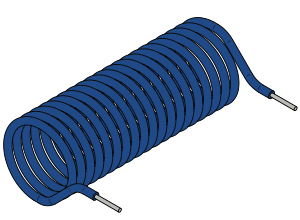Solenoid Applications
A solenoid is a tightly-wound coil of wire, with its length being substantially greater than its diameter. When an electric current runs through the solenoid, it exerts a uniform magnetic field from the center of the coil. Solenoids have a wide range of applications in the modern world, as the magnetic field which is created by the electric current can be turned on or off, and can be strengthened or weakened by adjusting the electric current. From car doors to medical equipment, solenoids are a common part of our everyday lives.

By Ryan Reed
The Main Idea
Solenoids can be found in electric locking mechanisms, medical equipment, cars, air conditioning systems, and numerous other devices. But first it is imperative that one understands how a solenoid produces a magnetic field in order to comprehend their usage in everyday life.
A Mathematical Model

The formula for the magnetic field of a solenoid is as follows:
- [math]\displaystyle{ B = \mu_0 \frac{N I}{l}. }[/math] where N is the number of turns in the coil, [math]\displaystyle{ \mu_0 }[/math] is the magnetic constant, [math]\displaystyle{ I }[/math] is the electric current, and [math]\displaystyle{ l }[/math] is the length of the solenoid.

In order to determine the direction of the magnetic field generated by a solenoid, simply use the right hand rule: curl you fingers in the direction of the current, and the direction that your thumb is pointing is the direction of the magnetic field.
Types of Solenoids
Linear Electromechanical Solenoid
Applications
Automobiles

Solenoids serve a wide variety of uses in modern cars. Automatic door lock systems would not be possible without solenoids. Starter solenoids, an integral part of a car's automatic starting system, aid in starting a car's engine when the key is turned. Most commonly, solenoids are used in automatic gearbox drive selectors, which prevent cars from switching to "drive" without first applying the brake pedal.
Locking Mechanisms
Solenoids are commonly used in electric locks to control locking mechanisms in doors, hotel locks, turnstiles, car doors, vending machines, etc. The applicability for solenoids in locking systems is endless.
Solenoid Valves

Solenoid valves are routinely seen in industrial applications. They control the flow of fluid through the valve by the use of a solenoid. Pneumatic solenoid valves control the flow of air to pneumatic systems, while hydraulic solenoid valves control the flow of hydraulic fluid in hydraulic machinery.
A List of Solenoid Valve Uses by Industry
http://www.gouldvalve.com/wp-content/uploads/2009/05/typical-uses-pages-1-3.pdf
Medical Field
Solenoids are frequently utilized in medical equipment. Solenoid valves are often used to control the rate of fluid in numerous machines, such as dialysis devices and dosing applications(blood flow through tubes). Solenoids are also used blood monitoring equipment. Because of their accuracy and durability, solenoids are a perfect fit in the medical industry.
Railway/Locomotives
The Railway industry also supplies solenoids with copious implementations. They are used in braking systems to stop locomotives. Solenoids can help ventilate and heat railway cars. They also can be used for automatic doors, toilets, turnstiles, and steps. Like automobiles, locomotives can use solenoids to their full potential.
An informative guide to solenoids in the Railway Industry
Connectedness
When we study physics in the classroom, the majority of it is from a theoretical perspective. We calculate electric and magnetic forces and fields, but at times it seems as if it is all just substance. However, it is applying the theory to real world applications which makes physics such an engaging and fascinating topics. Theory, such as the magnetic field of a solenoid, can be utilized in real world equipment and scenarios, as laid out in this page. The possibilities are endless, and it is so captivating and rewarding to see the material that we have learned in class come to fruition in industry. Most engineers will encounter a solenoid at some point in their career,
- How is this topic connected to something that you are interested in?
- How is it connected to your major?
- Is there an interesting industrial application?
History
Put this idea in historical context. Give the reader the Who, What, When, Where, and Why.
See also
Are there related topics or categories in this wiki resource for the curious reader to explore? How does this topic fit into that context?
Further reading
Books, Articles or other print media on this topic
External links
Internet resources on this topic
References
http://www.thesolenoidcompany.com/applications
http://www.gouldvalve.com/wp-content/uploads/2009/05/typical-uses-pages-1-3.pdf
http://constructionmanuals.tpub.com/14273/css/14273_56.htm
http://www.gemssensors.com/Solenoid-Valves
http://www.professionaldude.com/?solenoid-applications-in-the-modern-world,9